This was published 1 year ago
Walking with wildlife in Kenya is the ultimate adventure
By Julie Miller
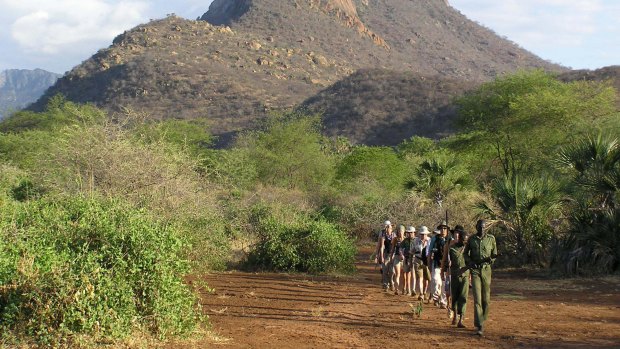
Tropical Ice is the only company with a licence to conduct walking safaris in Kenya's national parks.Credit: Tropical Ice
Finger to lips, Washii ushers us over a fallen log to gather on the edge of a river bank. Several metres below, in the caffe latte-coloured waters of the Tsavo River, a herd of 10 African elephants – from monumental tusked matriarchs to dumpling babies, appendages akimbo – are bathing, oblivious to our presence upwind.
For several minutes we admire in silence, muscles locked so as not to disturb this tranquil scene. Then, thirst sated, the mamas usher their splashing youngsters out of the shallows onto the bank, with just a narrow gulch dividing us.
Our guide, Iain Allan, raises a hand to indicate we wait and stand our ground. Even as the lead elephant suddenly becomes aware of 14 humans too close for comfort, we remain statue-like, albeit hearts galloping, as she flaps her ears and raises her trunk in a gesture of caution.
The herd matriarch bringing up the rear is more forthright. She rolls her head and whips her trunk in a definitive warning as Iain responds with a gentle "hup!". It's enough to stop her in her tracks and send the group passively on its way.
Exhale. Then there is the whispered chorus of "oh my god" as we relish this intimate encounter with the most charismatic beast of the African plains.
This is why we've travelled into the wilds of Kenya, enduring heat, dust and seeping blisters – for the opportunity to view wildlife on its terms, unencumbered by iron and steel, immersed in their environment and essentially part of the food chain.
For 10 days, our group of eight international adventurers – three recently retired American women, a father and his two adult sons from Scotland, a local Kenyan man and myself – will hike through Kenya's largest wilderness, 22,812 square kilometres in the shadow of Mount Kilimanjaro south-east of Nairobi, administered as two separate national parks, Tsavo West and East.
Following two of Africa's most alluring rivers – the Tsavo and the Galana – we'll traverse 160 kilometres from west to east on what is known as the Great Walk of Africa.
Started by legendary Kenyan mountaineer Iain Allan in 1978, Tropical Ice is the only company with a licence to conduct walking safaris in Kenya's national parks, with this signature two-week tour led personally by Iain or his business partner Alex Fickman.
This is Allan's 97th Great Walk, he tells us from the lobby of our first night's accommodation, Hemingways of Nairobi.
While we have every creature comfort on hand in this luxury hotel, from here on we'll be staying in safari fly camps, upended each morning with a "leave no trace" policy by the 20-man Tropical Ice team while we walk between 10 and 23 kilometres to the next location.
DAY ONE
Nairobi to Kilaguni Lodge, Tsavo West National Park
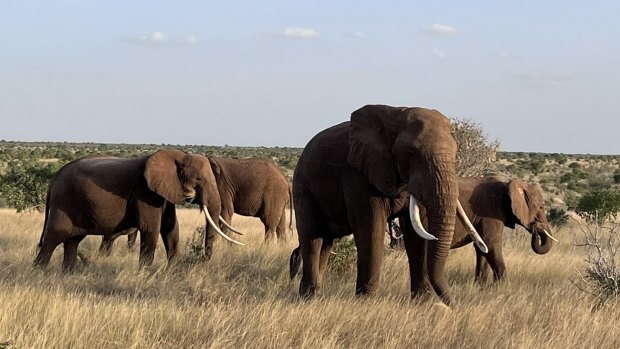
Credit: Classic Safari Company
While we are all aware of the enormity of the physical challenge at hand – I've certainly never walked 160 kilometres all at once - the realities of the potential danger of this undertaking soon becomes apparent in the most exigent of safety briefings.
We'll be walking single file in absolute silence for five hours a day: Iain leading the way, armed with a .416 Rigby elephant rifle, followed by Washii, a Samburu tracker wielding a spear, and the lofty Tioko, also carrying a rifle.
At the end of the line will be another two armed bushmen, Etukan and Lokorio, with hawk-like eyes capable of spotting game from impossible distances.
For our safety, we are to obey our guides' every command, tuning into their body language as they scan the dense tangle of foliage for lurking creatures.
It's serious stuff, though presented with a touch of much-needed levity with Allan's wry "If you get it wrong, go with dignity" advice becoming a much-repeated catchphrase throughout our journey.
Killing an estimated 500 people a year, the animal to be most wary of is the hippo - a territorial beast that will charge on instinct, blind with unstoppable rage if the path between it and its aqueous home is blocked.
With Kenya suffering prolonged drought, hippos are being forced further afield to graze each night, their delayed return to the river creating a potentially volatile situation. And when it comes to guest safety, there's no choice for an enraged hippo but to come off second best.
Elephants, though equally foreboding, are a different story: they are smart, evolved animals, capable of reason and complex thought processes.
"The elephant is one of the most supreme creatures on this planet," Allan says, totally enamoured with the animal he has been studying his whole adult life.
An irate elephant should respond to a warning shout, or at worst a shot fired above its head: "The day I am forced to shoot an elephant is the day I give this up," Iain tells us.
DAYS TWO AND THREE
Overnight Kudu Camp and Kichwa Tembo Camp
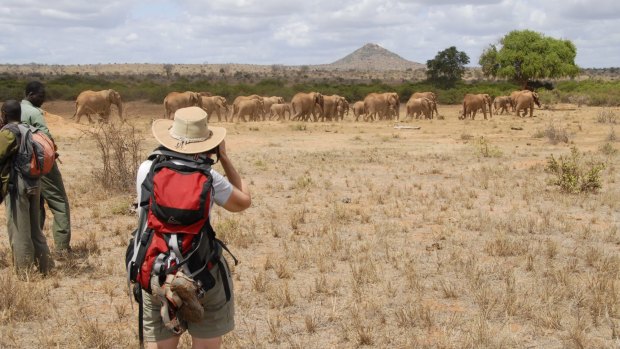
Credit: How can such a rugged, lean landscape sustain any wildlife, let alone more than 13,000 elephants? Tropical Ice
In Out of Africa, Danish author Karen Blixen described the low country of Kenya as having "no fat on it and no luxuriance anywhere".
As we begin our silent progression the following morning from the source of the Tsavo River at Mzima Springs, there's something difficult to comprehend.
How can such a rugged, lean landscape, characterised by red volcanic soil and barbed acacia bushes that clutch and tear at skin and hair, sustain any wildlife, let alone more than 13,000 elephants – including most of Africa's few remaining "super tuskers".
Tsavo West is big game country: rather than the teeming herds of grazers found further east or on the open plains of the Maasai Mara, it's Africa's giants that dominate the acacia woodlands, with elephants, hippos and Cape buffalo responsible not only for the age-old trails we duck and weave along but also the most intense sightings.
With few tourists, the wildlife in Tsavo is not used to the presence of vehicles, let alone hikers on foot; and for many elephants, humans are associated with the terrors of poaching, which decimated their numbers during the '70s and '80s.
One lone bull elephant, camouflaged in dense foliage just metres away, lets his displeasure be known with a mock charge before making his retreat; while we respectfully skirt around a foraging family group crossing our path, ushered through prickly barricades of "wait-a-bit" thorns in hasty silence by Washii and Tioko.
Meanwhile, our intimate vantage point reveals the less feted creatures of the scrublands; a family of warthogs, scuffing through the dust; tiny dik-dik, the smallest of the antelope family, erupting from thorny clumps; even a puff adder, curled up in a rock crevice in silent wait for passing prey.
Elegant giraffes waltz across the horizon; fringe-eared oryx pierce the sky with unicorn horns; while Iain's warnings about errant hippos is realised early on our second walk, resulting in raised firearms, a rapid retreat and surging adrenaline but thankfully nothing more dramatic.
Day two of our walk also sees the first of 18 river crossings, a nerve-wracking experience. Boots removed, we cross at the widest and shallowest points of the river at known elephant crossings, where crocs and hippos are less likely to lurk; linking arms with a chosen partner, we move as a tight unit, emulating pachyderms with stomping legs.
DAYS FOUR TO FIVE
Maji Ya Chumvi Camp and Maneaters Camp
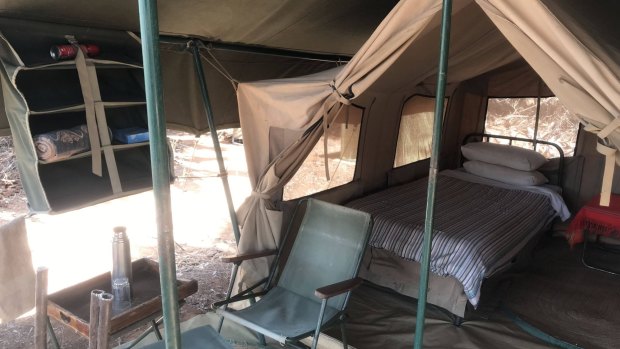
Appearing like a mirage on secluded river bends, the private Tropical Ice campsites are a welcome haven, nestled strategically under the shade of towering doum palms, papery fronds rustling in the breeze.
Six canvas safari tents have been erected in a line to capture river views, each spacious enough for two single beds, with an outdoor seating area and flanked by a separate long-drop thunderbox and canvas bush shower.
While rustic, it's the niceties that we're grateful for: clean sheets and towels, a bowl of fresh water to splash off the dust, replenished filtered drinking water, and a daily laundry service to ensure we start each day in a reasonably tidy state.
Later in the evening, a steaming bucket of hot water provides the most restorative of showers, filthy hiking gear replaced by colourful kikois – colourful Swahili sarongs gifted to us by Tropical Ice, and worn as we gather around a campfire for pre-dinner drinks.
Ravenous after our daily exercise, meals provide a chance to refuel and unwind over lively conversation, gifted raconteur Iain holding court with tales of close encounters, an encyclopaedic knowledge of Hollywood movies and Beatles trivia.
What chef Kahiu produces in his simple bush kitchen, cooking over an open flame fuelled by recycled coffee husks, is truly astounding.
Following a menu curated by Allan's Australian wife, Lou, we gorge on fresh salads, gourmet platters of eggplant parmigiana, barbecued kebabs, Swahili curries, freshly baked bread and delectable puddings.
Legs weary and bellies full, we retire to our tents after lunch for a siesta before regrouping about 4pm for afternoon game drives.
Travelling in customised Land Rovers provides more relaxed encounters than on foot and we are rewarded by photo opportunities. We capture prowling hyenas, mega-herds of buffalo en route to the river, trotting zebras, white stripes smeared with red dust, and even several prides of Tsavo's famous maneless lions, males sporting scruffy mohawks in an adaptation to their prickly environment.
Meanwhile, technicolour African sunsets are toasted with Tusker beers and G&Ts from elevated rock platforms, the dramatic, craggy ridgeline of the Ngulia Hills and the flat-topped Yatta Plateau – the longest lava flow in the world – marking our westward progression as the riverine vegetation gives way to increasingly arid plains.
DAY SIX TO EIGHT
Tsavo East National Park and Epiya Chapeyu Camp
The wilderness of Tsavo West and East National Parks is divided by two jarring man-made anomalies: a highway and a railway line, both linking the port of Mombasa to the capital Nairobi and beyond.
It was during the building of the railroad bridge in 1898 that Tsavo's most infamous man versus animal conflict entered both history and legend, recorded by the railway project manager Lieutenant-Colonel John Patterson in his book, The Man-eaters of Tsavo.
For nine months, two Tsavo lions – nicknamed Ghost and the Darkness - terrorised the construction campsites, dragging dozens of hapless Indian workers from their tents at night and devouring them.
The official death toll was at least 35 with more than 100 workers unaccounted for. Scientific studies on the corpses of the lions – eventually shot by Patterson himself – revealed humans made up 30 per cent of their diet.
In typical theatrical manner, Allan leads us down a trail near the highway, producing a dog-eared second edition copy of Patterson's book and reading a passage where he finds the so-called den of the man-eaters.
Then, lo and behold, around a corner we spy the actual rocky overhang, matching the photograph in the book – a location discovered by Allan himself during a search in the 1990s.
From the sadly dilapidated Tsavo Railway Station, we notice a marked shift in the landscape, the meandering Galana River, a lifeline for massive herds of zebra, giraffe, impala and buffalo that make a daily trek through arid flatlands to its white sandy beaches.
This is also ideal lion country, the apex predators lying in lazy anticipation for grazers to appear, dozing in the shade of scrubby saltbush during the heat of day.
As predicted earlier by Allan, our first encounter with lions on foot is somewhat of an anti-climax. First spotted by Etukan at the back of the line as we scramble up a dry creek bed, Iain practically stumbles into the pride at the front, spooking them from their slumber under a stunted coastal oak.
Beckoned back down the hill by Etukan, I am discombobulated as Allan also urges me forward for a closer view; and by the time I fix my gaze on the skittish simba, they are bounding into the distance. "See, lions aren't the king of the jungle," Allan says. "Elephants are."
In this thirsty landscape, home base has become even more enticing - we now have the luxury of three nights in a row spent at two camps, riverside leases exclusive to Tropical Ice.
The first, Epiya Chapeyu, is postcard perfect, occupying a wide bend of the Galana with a resort-worthy white sand beach and palm-lined banks occupied by two resident bull elephants.
Binoculars raised, we while away time gazing at these regal tuskers ambling across the river, trunks raised in seemingly congenial greeting. I wake one night to enormous black shadows passing silently by my tent and I'm unsure if I am hallucinating. I later find fresh dung and footprints as evidence of the midnight rendezvous.
DAYS NINE TO 11
Durusirkale Camp
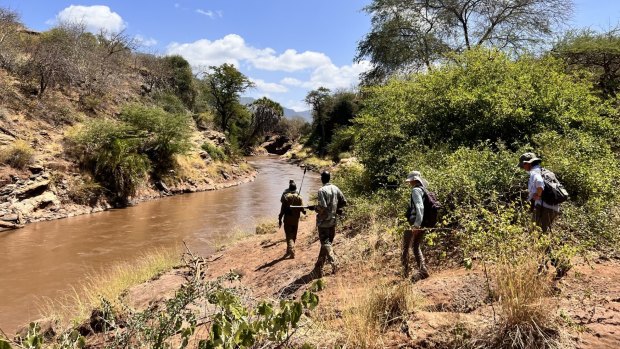
Credit: The Classic Safari Company
After a sunset game drive from our second camp, Durusirkale - largely spent watching a trio of lion cubs tussling over a leather sandal (how, why, and where is the foot it was attached to?) - we are later paid a visit by the very same pride, setting up vigil less than 30 metres from our tents.
Following a watchful dinner, we are chaperoned through camp by Tioko and his rifle, nervously wishing each other godspeed as we retire with the well-worn advice: "Go with dignity!"
There's no addition to the man-eaters' tally, fortunately – and after nine days of safari, we are greeted with a tangerine African sunrise and the traditional wake-up call of "Jambo!" to begin our final day's trek.
This is to be a double-header – a 13-kilometre morning walk, followed by a picnic lunch and another eight kilometres before reaching our final destination of Sala Gate, the eastern entrance to the national park.
Twenty-one kilometres, four river crossings – we're certainly going out with a bang. A monumental effort is required under a cloudless sky and into an impeding headwind.
But as we make our final river crossing and push through the final kilometre, exhaustion is replaced by elation, overwhelming pride that we have dug deep to achieve something only 800 others have attempted in more than 40 years.
I may have blisters for days, groaning muscles and be covered in a layer of dust that needs chiselling to remove, but this compelling journey, walking as one with the king of the African plains, is surely the ultimate adventure.
Julie Miller travelled to Kenya as a guest of the Classic Safari Company.
FIVE MORE ANIMALS TO SPOT ON SAFARI
Gerenuk
Also known as the "giraffe gazelle", this long-necked antelope with manga eyes and comical ears is the most perfectly adapted of Tsavo's wildlife, gaining all of its water requirements from grazing and foraging.
Hyena
It's always exciting to see Africa's predators on the hunt. While arguably the most maligned creature of Africa, there's a lot to admire about this fascinating dog-like pack-hunter and scavenger.
Red-billed quelea
Every evening sees massive flocks of this tiny bird – the most populous undomesticated bird in the world with an estimate of 1.2 billion individuals - create smoke-like plumes as they swarm from feeding grounds back to their evening perch.
Cape buffalo
After hippos, a lone bull Cape buffalo is the most feared creature to encounter on a walking safari and must always be treated with caution. To witness huge herds as they descend on the river for their daily quench is an incredible, humbling sight.
Puff adder
Samburu warriors may be fearless in the face of a charging elephant but one creature they do fear is the deadly puff adder. Able to remain invisible in ground cover, our group experienced two adrenaline pumping encounters with this venomous viper.
THE DETAILS
WALK
The 14-day Great Walk of Africa includes internal flights within Kenya, 10 days of hiking, all-inclusive fully deluxe camping, guides, staff and park permit fees. Safari from $US11,850 ($16,965) a person, with dates available from 2023. See classicsafaricompany.com.au
STAY
Guests, as part of the Classic Safari Company tour cost, stay at the luxurious Hemingways Nairobi set on the former estate of Karin Blixen before the walk. After completing the hike, the group flies from Malindi to the island of Lamu for a night of relaxation in this atmospheric ancient Swahili settlement.
FLY
From Australia, Emirates flies from Sydney and Melbourne to Nairobi, via its Dubai hub. In Kenya, note that charter flight luggage is restricted to 15 kilograms, with soft-side luggage preferable. See emirates.com
Sign up for the Traveller Deals newsletter
Get exclusive travel deals delivered straight to your inbox. Sign up now.